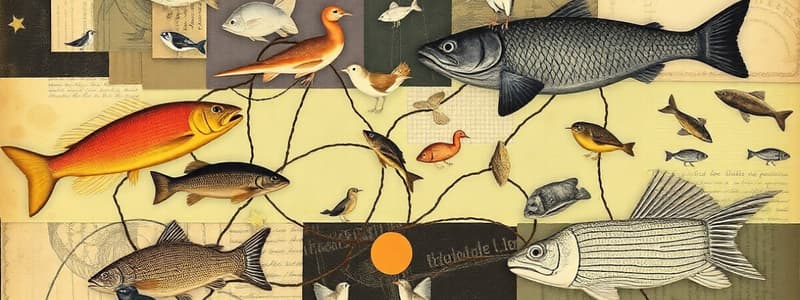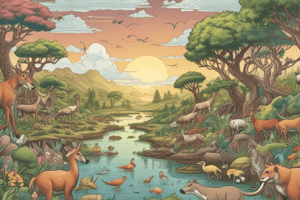Podcast
Questions and Answers
How would the removal of a primary consumer, such as zooplankton, from an aquatic food web impact both the producer and secondary consumer populations?
How would the removal of a primary consumer, such as zooplankton, from an aquatic food web impact both the producer and secondary consumer populations?
The producer population would likely increase due to decreased consumption. The secondary consumer population would likely decrease due to a reduced food source.
Explain how deforestation can simultaneously impact local biodiversity and global climate patterns.
Explain how deforestation can simultaneously impact local biodiversity and global climate patterns.
Locally it reduces habitats and species diversity. Globally it reduces carbon sequestration leading to increased atmospheric carbon and altered weather patterns.
Describe a scenario where a marine ecosystem experiences both overfishing and plastic pollution. What are the combined impacts?
Describe a scenario where a marine ecosystem experiences both overfishing and plastic pollution. What are the combined impacts?
Declining fish populations due to overfishing combined with habitat degradation and ingestion of plastics by marine life would result in a severely compromised ecosystem, potentially leading to ecosystem collapse.
A rock has a mass of 15 kg. Calculate its weight on Earth and then explain how its mass and weight would differ on the moon, where gravitational acceleration is approximately 1.6 m/s².
A rock has a mass of 15 kg. Calculate its weight on Earth and then explain how its mass and weight would differ on the moon, where gravitational acceleration is approximately 1.6 m/s².
A block of wood with a volume of 0.002 m³ floats on water (density 1000 kg/m³), with half of its volume submerged. Calculate the buoyant force acting on the wood and then determine the density of the wood.
A block of wood with a volume of 0.002 m³ floats on water (density 1000 kg/m³), with half of its volume submerged. Calculate the buoyant force acting on the wood and then determine the density of the wood.
Explain how introducing a new, highly competitive plant species to an established ecosystem could affect the native plant populations and the herbivores that depend on them.
Explain how introducing a new, highly competitive plant species to an established ecosystem could affect the native plant populations and the herbivores that depend on them.
Describe how climate change-induced ocean acidification can affect marine food webs, particularly focusing on organisms with calcium carbonate shells or skeletons.
Describe how climate change-induced ocean acidification can affect marine food webs, particularly focusing on organisms with calcium carbonate shells or skeletons.
Consider a scenario where a power plant releases thermal pollution into a river. How might this affect the fish populations and overall aquatic ecosystem?
Consider a scenario where a power plant releases thermal pollution into a river. How might this affect the fish populations and overall aquatic ecosystem?
A metal cube measures 0.1 meters on each side and has a mass of 8 kg. Will this cube float or $\sink$ in water (density = 1000 kg/m³)? Explain your answer.
A metal cube measures 0.1 meters on each side and has a mass of 8 kg. Will this cube float or $\sink$ in water (density = 1000 kg/m³)? Explain your answer.
In a simple electrical circuit with a 12V battery and a single resistor, explain what happens to the current if you add a second identical resistor in series. Explain why.
In a simple electrical circuit with a 12V battery and a single resistor, explain what happens to the current if you add a second identical resistor in series. Explain why.
Flashcards
Food Chain
Food Chain
A linear sequence showing energy transfer between organisms.
Food Web
Food Web
Interconnected food chains showing complex feeding relationships.
Producers
Producers
Organisms that make their own food using sunlight.
Consumers
Consumers
Signup and view all the flashcards
Decomposers
Decomposers
Signup and view all the flashcards
Bioaccumulation
Bioaccumulation
Signup and view all the flashcards
Force
Force
Signup and view all the flashcards
Weight
Weight
Signup and view all the flashcards
Mass
Mass
Signup and view all the flashcards
Electrical Circuit
Electrical Circuit
Signup and view all the flashcards
Study Notes
Okay, here are the updated study notes based on the provided text. Note that since the provided text is identical, I will not add any new information.
### Food Chains and Food Webs
- A food chain illustrates a linear sequence of organisms where each consumes the one before it, transferring energy and nutrients.
- A food web is a complex network of interconnected food chains, showing the diverse feeding relationships within an ecosystem.
- Producers (e.g., plants) form the base of a food chain, converting sunlight into energy through photosynthesis.
- Consumers obtain energy by feeding on other organisms; they can be herbivores, carnivores, or omnivores.
- Decomposers (e.g., bacteria and fungi) break down dead organisms, returning nutrients to the ecosystem.
- Energy transfer in a food web is inefficient; only about 10% of the energy at one trophic level is transferred to the next, the rest is lost as heat.
- Disruptions to a food web, such as the removal of a keystone species or the introduction of an invasive species, can have cascading effects on the ecosystem.
- Bioaccumulation refers to the increasing concentration of toxins in organisms at higher trophic levels.
### Harm to Ecosystems
- Pollution, including chemical runoff and plastic waste, degrades habitats and harms wildlife.
- Deforestation reduces biodiversity, disrupts water cycles, and contributes to climate change.
- Overfishing depletes fish populations and disrupts marine ecosystems.
- Climate change leads to habitat loss, altered migration patterns, and increased frequency of extreme weather events.
- Invasive species can outcompete native species, alter food webs, and transmit diseases.
### Force, Weight, and Mass
- Force is a push or pull that can change the motion of an object; measured in newtons (N).
- Weight is the force of gravity acting on an object's mass; also measured in newtons (N).
- Mass is the amount of matter in an object; measured in kilograms (kg).
- Weight = mass × gravitational acceleration (approximately 9.8 m/s² on Earth).
- An object's mass remains constant, but its weight can change depending on the gravitational field.
### Floating and Sinking
- An object floats if the buoyant force (upward force exerted by a fluid) is equal to or greater than its weight.
- An object sinks if its weight is greater than the buoyant force.
- Density is mass per unit volume (ρ = m/V); an object floats if its density is less than the density of the fluid.
- Archimedes' principle: the buoyant force on an object is equal to the weight of the fluid it displaces.
### Electrical Circuits and Components
- An electrical circuit is a closed loop that allows electric current to flow.
- Key components include:
- Power source (e.g., battery) provides voltage.
- Wires conduct current.
- Resistors limit current flow.
- Switches control the flow of current.
- Light bulbs convert electrical energy into light and heat.
- Current (I) is the rate of flow of electric charge; measured in amperes (A).
- Voltage (V) is the electrical potential difference; measured in volts (V).
- Resistance (R) is the opposition to current flow; measured in ohms (Ω).
- Ohm's Law: V = IR (Voltage = Current × Resistance).
- Series circuits: components are connected in a single path; current is the same through each component, and voltages add up.
- Parallel circuits: components are connected in multiple paths; voltage is the same across each component, and currents add up.
Studying That Suits You
Use AI to generate personalized quizzes and flashcards to suit your learning preferences.




